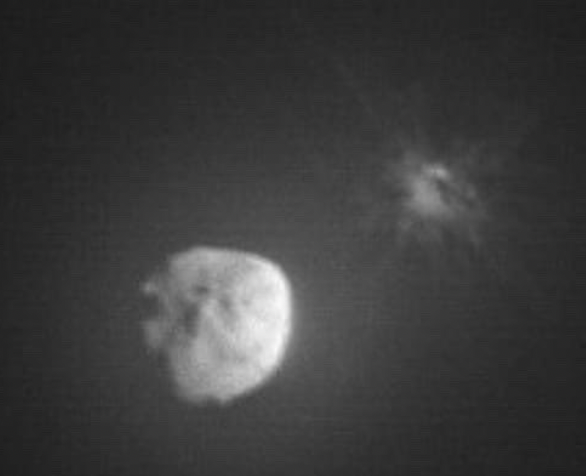NASA's DART Mission confirmed an "impact success" status for its recent kamikaze venture towards the Dimorphos asteroid which aims to test if any collision would change trajectory even a tiny bit. However, while that is still under investigation from NASA and the team, the LICIACube which set up shop days earlier to document the crash, released the first photos of the earlier event.
NASA DART: First Images from LICIACube

(Photo : ASI/NASA via LICIACube on Twitter)
The LICIACube team released the first images of its documentation of the NASA DART Mission as it went on its way towards the Apollo constellation region and hit the Dimorphos asteroid. The images were taken when the CubeSat already hit Dimorphos early yesterday, and it shows the after-effects of what took place after NASA's earlier video of the impact.
The images show Didymos to be the larger space rock in the snaps, with Didymos and the remnants of DART appearing with its rubble and gas clouds as evident in the images.
LICIACube's snaps show what DART left on the region, and it looks like it did a number on the asteroid as it collided with it as part of the mission.
Read Also: [LOOK] NASA DART Mission Captures Epic Images Before Asteroid Impact
Here are the first images taken by #LICIACube of #DARTmission impact on asteroid #Dimorphos.
Now weeks and months of hard work are now starting for scientists and technicians involved in this mission, so stay tuned because we will have a lot to tell! pic.twitter.com/kVz1WmcsL7— LICIACube (@LICIACube) September 27, 2022
Did Dimorphos Change Trajectory?
For now, researchers will look into Dimorphos' orbit to see if there are changes, even by a tiny bit, especially as an impact like that would have resulted in some differences.
One user asked if there was a change in trajectory for the space rock, and the LICIACube team said that there would not be much of a change as it is "physically impossible." The team added that it may only be closer to its parent asteroid's orbit after the DART Mission.
NASA DART and its Relevance
Small things matter as even tiny changes in the universe creates ripple effects that may change things significantly in the future. Some examples would be a splinter causing people intense pain or hitting one's toe on a table end, which also generates excruciating feelings.
And the same goes for NASA's latest mission which took place near the Apollo constellation group, particularly with the near-Earth potentially hazardous asteroid, Didymos. The target of the team is an orbiting space rock around it, Dimorphos, something which is only what the team aims to test to see if it has any effect on future space rocks on their way to the planet.
Despite the advancement in munitions and explosives the present, the European Space Agency prefers not to bomb things in space which was different from NASA's original goal.
Here, DART was conceived to look into changing the trajectory of a space rock without the use of lethal force.
Now, one of the most essential tests in Earth's planetary defense took place, presenting a study for researchers to look into possible ways to redirect asteroids and space rocks that may be headed towards the planet in the future. And while they are doing that, the public may marvel at the photos from the LICIACube available now.
Related Article: NASA DART Mission: Impact Success, Spacecraft Hits Asteroid Dimorphos [WATCH]
This article is owned by TechTimes
Written by Isaiah Richard





